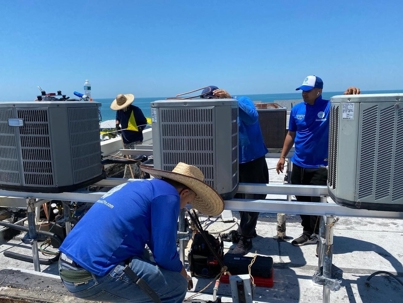What Is Commercial AC Installation and Why It Matters?
Brief Introduction to Commercial Air Conditioning Systems
Commercial air conditioning (AC) systems are critical for ensuring the comfort of employees and customers in various business settings, from small retail stores to large office buildings. Unlike residential systems, commercial AC units are engineered to handle the larger spaces and complex requirements of commercial environments.
These systems can include various configurations, such as split systems, rooftop units, and packaged systems. They are designed to maintain optimal indoor temperatures while ensuring adequate ventilation and air quality. Properly installed and maintained systems contribute to a commercial space’s overall comfort and efficiency, directly impacting productivity and customer satisfaction.
Importance of Proper Installation for Business Efficiency and Comfort
Commercial AC Installation Costs system significantly influences its operational efficiency and effectiveness. A poorly installed system can lead to increased energy consumption, higher operating costs, and frequent maintenance issues. In contrast, a well-executed installation optimizes airflow and temperature control, vital for maintaining a comfortable atmosphere for employees and clients.
Moreover, compliant installation with local regulations and energy efficiency standards can yield substantial cost savings over time. This makes professional installation a matter of immediate comfort and a long-term investment in operational efficiency and energy savings.
Section 1: Factors That Affect Commercial AC Installation Costs
1.1 Size and Scope of the Project
The size and complexity of the building significantly impact installation costs. Larger buildings require more robust systems to effectively cool or heat the space, leading to higher equipment and installation costs.
For instance, a small office may effectively utilize a single split system. At the same time, a multi-story commercial building might require multiple rooftop units, ductwork, and sophisticated controls, all of which contribute to increased costs. Additionally, buildings with unique layouts or structural challenges may need customized installation solutions that further elevate expenses.
1.2 Type of Commercial AC System
Various commercial AC systems are available, each designed for different applications and budget considerations. Common types include:
- Split Systems: Generally cost-effective and suitable for various applications, these systems typically range from $5,000 to $20,000 in installation costs.
- Rooftop Units (RTUs): Often ideal for more significant commercial buildings, RTUs can cost between $10,000 and $45,000, depending on their capacity and features.
- Variable Refrigerant Flow (VRF) Systems: Known for their energy efficiency and zoning capabilities, installation costs can range from $10,000 for simpler setups to $50,000 for more complex systems.
The chosen system type plays a crucial role in determining the total installation costs. Each offers distinct benefits and challenges regarding installation complexity and operational efficiency.
1.3 Efficiency Ratings (SEER & EER)
Energy efficiency ratings are another critical factor affecting installation costs. The Seasonal Energy Efficiency Ratio (SEER) and Energy Efficiency Ratio (EER) are standard metrics used to measure AC system efficiency.
Systems with higher efficiency ratings often have a higher upfront cost. However, investing in energy-efficient systems can lead to lower energy bills and more significant savings over time. For example, a system with a higher SEER rating could save a business thousands of dollars in energy costs annually, making it a wise long-term investment.
1.4 Building Layout and Existing Infrastructure
The layout of the building and the existing infrastructure greatly influence installation pricing. Features like ductwork, insulation, and the electrical system need to be evaluated when estimating costs.
If the building already has well-maintained ductwork, reusing it may minimize installation costs. Conversely, if new ductwork or extensive renovations are needed, the total installation costs will be escalated.
1.5 Brand and Model Selection
The choice of brand and model significantly impacts HVAC installation costs. Premium brands may demand a higher price due to their reputation for reliability, longevity, and superior performance.
For instance, choosing a robust and trustworthy brand such as Momentum AC & Electric can ensure a dependable system and lead to long-term energy savings and lower maintenance costs. Business owners must evaluate the total cost of ownership, including possible savings from more efficient models, rather than solely focusing on upfront costs.
1.6 Customization and Special Requirements
Customization can also increase installation costs. Many businesses require specific adaptations, such as zoning systems to control temperature in different areas or energy-efficient upgrades, such as smart thermostats.
Special requests can complicate the installation process and require additional materials or skilled labor, raising the overall price. Assessing these needs during the planning stages allows businesses to budget more accurately.
Section 2: Breakdown of Cost Components in Commercial AC Installation
2.1 Equipment Costs
Equipment costs constitute one of the most significant expenses in commercial AC installation. This includes the price of the chosen HVAC unit and any additional components required for installation, such as ductwork and accessories.
The specific system type and capacity will determine the extent of these costs. For instance, a larger packaged unit will naturally carry a higher price tag than a smaller split system. Proper budgeting should consider these factors to avoid unexpected expenses during the installation phase.
2.2 Labor Costs
Labor costs vary widely depending on several factors, including the project’s complexity and regional labor rates. Skilled technicians are essential for the installation process, ensuring the system is installed correctly and complies with regulations.
Labor costs may be higher in high-demand areas or during peak seasons. Therefore, business owners should obtain multiple contractor quotes to gauge a fair labor rate.
2.3 Additional Materials
In addition to equipment and labor costs, other materials such as insulation, mounting equipment, and electrical wiring contribute to the total expenses.
These materials are often overlooked, yet they can add significantly to the final price. A comprehensive cost estimate should include these additional items to avoid budget overruns later in the project.
2.4 Permits and Inspections
Legal requirements often necessitate obtaining permits and undergoing inspections during commercial AC installation. These steps help ensure the installation complies with local codes and safety regulations.
The costs of these permits and inspections can vary depending on location and complexity. Therefore, businesses must consider these fees in their budget, as neglecting them can lead to delays or additional costs.
Section 3: Comparing Commercial AC Installation to Residential Installation
3.1 Key Differences Between Commercial and Residential Systems
Commercial and residential HVAC systems differ in several aspects, primarily in size, usage, and complexity.
Commercial systems are designed to handle more prominent spaces and higher demands. They typically incorporate more complex controls and may include features like variable refrigerant flow for zoning, which are rare in residential systems.
3.2 Cost Differences Between Commercial and Residential Installations
Commercial AC installation costs are generally higher than residential systems, factoring in larger equipment sizes and more extensive installation needs.
For example, while a residential AC unit installation might cost $4,000 to $10,000, commercial installations can typically cost between $10,000 and $45,000, depending on the system type and building requirements.
Section 4: Understanding Long-Term Value and Return on Investment (ROI)
4.1 Energy Savings Over Time
Investing in energy-efficient commercial AC systems can be financially rewarding in the long run. Systems with high-efficiency ratings, such as those offered by Momentum AC & Electric, often result in lower utility bills.
Despite the initial investment, these systems can pay for themselves over time through significant energy savings, making them a valuable asset for any business.
4.2 Maintenance and Repair Costs
Regular maintenance is crucial for prolonging the lifespan of commercial HVAC systems and minimizing repair costs. The expenses associated with maintenance can be substantial, especially if a system is not adequately cared for.
Investing in a quality installation initially may reduce the need for frequent repairs, enhancing overall ROI. Preventative maintenance programs, through regular check-ups and prompt attention to minor issues, can also help reduce long-term costs.
4.3 Impact on Property Value
A well-installed commercial AC system can increase a property’s overall value. Prospective buyers or tenants may view energy-efficient systems as a favorable attribute, improving the property’s marketability.
Quality installations improve comfort and air quality, demonstrate good upkeep and investment in the facility, and positively influence property appraisals.
Section 5: Tips for Reducing Commercial AC Installation Costs
5.1 Choosing the Right Contractor
Selecting a qualified contractor ensures the installation is performed correctly and efficiently. Business owners should obtain multiple quotes from various contractors, checking qualifications and reviews to find reputable installers.
A good contractor should provide a detailed breakdown of costs, allowing for better comparison and ensuring no hidden fees arise.
5.2 Timing Your Installation
Choosing the right time of year for installation can lead to cost savings. For instance, scheduling installations during the off-peak season often results in lower labor costs and better equipment availability.
Businesses should also consider the weather, as avoiding extreme conditions can help protect both equipment and installation personnel.
5.3 Exploring Financing Options
Financing solutions can make the initial expenses more manageable. Many HVAC companies offer financing plans for their products or services, enabling businesses to spread payment over time.
It’s beneficial for business owners to explore different financing options tailored to their specific needs. This allows for a smart investment without compromising cash flow.
5.4 Government Incentives and Rebates
Many federal, state, and local programs offer incentives or rebates for energy-efficient HVAC systems. These can significantly reduce initial installation costs, making high-efficiency options more accessible.
Businesses should investigate available programs to take full advantage of potential savings on their commercial AC investments.
Frequently Asked Questions (FAQs)
How long does it take to install a commercial AC system?
The installation duration varies based on system complexity and project size. Typical installations can take anywhere from a few days to several weeks.
What is the average cost of commercial AC installation?
On average, commercial AC installation costs range from $10,000 to $45,000, and they are influenced by factors such as system type and building requirements.
How often should a commercial AC system be replaced?
Commercial AC systems typically last 15 to 25 years, depending on usage, maintenance, and technological advancements. Regular assessments will provide insights into whether a replacement is necessary.
Is there a difference in installation costs for rooftop units vs. indoor systems?
Yes, rooftop units generally have higher installation costs due to the complexity involved in their installation and maintenance compared to indoor systems.
What maintenance is required after a commercial AC installation?
Routine maintenance includes filter replacements, system inspections, and calibrations performed 1-2 times yearly to ensure efficient operation.
Can an existing duct system be reused in a new installation?
Reusing existing ductwork is an option if it is in good condition and meets the new system’s requirements. However, based on system specifications, modifications may be necessary.
How do I know if my building needs a zoning system?
Buildings requiring different temperatures in separate areas may benefit from a zoning system. Consult an HVAC professional to assess heating and cooling needs.
Conclusion
In summary, understanding the various factors that influence commercial AC installation costs can empower business owners to make informed decisions about their HVAC systems. Key elements such as the size and scope of the project, the type of system selected, energy efficiency ratings, and building infrastructure all play significant roles in determining the overall expenses. Also, choosing a reputable contractor and strategically timing the installation can yield substantial cost savings.

